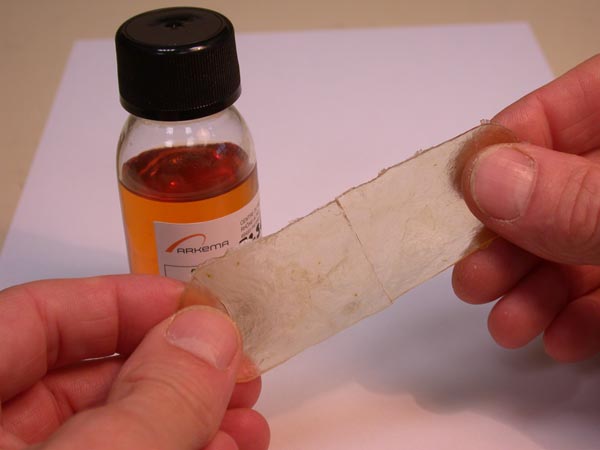What are Smart Materials ?
Smart materials are materials that have one or more properties that can be significantly changed in a controlled fashion by external stimuli, such as stress, temperature, moisture, pH, electric or magnetic fields.
A smart fluid developed in labs at the Michigan Institute of Technology
Smart materials have one or more properties that can be dramatically altered. Most everyday materials have physical properties, which cannot be significantly altered, for example if oil is heated it will become a little thinner, whereas a smart material with variable viscosity may turn from a fluid which flows easily to a solid. A variety of smart materials already exist, and are being researched extensively.
Flexible Transistor - Electrodes flex for artificial consumer electronics
These include piezoelectric materials, magneto-rheostatic materials, electro-rheostatic materials, and shape memory alloys. Some everyday items are already incorporating smart materials (coffeepots, cars, the International Space Station, eyeglasses) and the number of applications for them is growing steadily.
Smart Print Materials
Each individual type of smart material has a different property which can be significantly altered, such as viscosity, volume, and conductivity. The property that can be altered influences what types of applications the smart material can be used for.
Smart Textile
Science and technology have made amazing developments in the design of electronics and machinery using standard materials, which do not have particularly special properties (i.e. steel, aluminum, gold). Imagine the range of possibilities, which exist for special materials that have properties scientists can manipulate. Some such materials have the ability to change shape or size simply by adding a little bit of heat, or to change from a liquid to a solid almost instantly when near a magnet, these materials are called smart materials.
Piezoelectric Materials
Piezoelectric materials have two unique properties which are interrelated. When a piezoelectric material is deformed, it gives off a small but measurable electrical discharge. Alternately, when an electrical current is passed through a piezoelectric material it experiences a significant increase in size (up to a 4% change in volume).
Piezoelectric materials are most widely used as sensors in different environments. They are often used to measure fluid compositions, fluid density, fluid viscosity, or the force of an impact. An example of a piezoelectric material in everyday life is the airbag sensor in your car. The material senses the force of an impact on the car and sends and electric charge deploying the airbag.
Piezoelectricity is the charge which accumulates in certain solid materials (notably crystals, certain ceramics, and biological matter such as bone, DNA and various proteins) in response to applied mechanical stress. The word piezoelectricity means electricity resulting from pressure.
Piezoelectric disk used as a guitar pickup
It is derived from the Greek piezo or piezein, which means to squeeze or press, and electric or electron, which stands for amber, an ancient source of electric charge. Piezoelectricity is the direct result of the piezoelectric effect.
The first practical application for piezoelectric devices was sonar, first developed during World War I. In France in 1917, Paul Langevin and his coworkers developed an ultrasonic submarine detector. The detector consisted of a transducer, made of thin quartz crystals carefully glued between two steel plates, and a hydrophone to detect the returned echo. By emitting a high-frequency chirp from the transducer, and measuring the amount of time it takes to hear an echo from the sound waves bouncing off an object, one can calculate the distance to that object.
The use of piezoelectricity in sonar, and the success of that project, created intense development interest in piezoelectric devices. Over the next few decades, new piezoelectric materials and new applications for those materials were explored and developed. The pyroelectric effect, where a material generates an electric potential in response to a temperature change, was studied by Carl Linnaeus and Franz Aepinus in the mid-18th century. Drawing on this knowledge, both René Just Haüy and Antoine César Becquerel posited a relationship between mechanical stress and electric charge; however, experiments by both proved inconclusive.
The first demonstration of the direct piezoelectric effect was in 1880 by the brothers Pierre Curie and Jacques Curie. They combined their knowledge of pyroelectricity with their understanding of the underlying crystal structures that gave rise to pyroelectricity to predict crystal behavior, and demonstrated the effect using crystals of tourmaline, quartz, topaz, cane sugar, and Rochelle salt (sodium potassium tartrate tetrahydrate). Quartz and Rochelle salt exhibited the most piezoelectricity.
The piezoelectric effect is understood as the linear electromechanical interaction between the mechanical and the electrical state in crystalline materials with no inversion symmetry. The piezoelectric effect is a reversible process in that materials exhibiting the direct piezoelectric effect (the internal generation of electrical charge resulting from an applied mechanical force) also exhibit the reverse piezoelectric effect (the internal generation of a mechanical strain resulting from an applied electrical field). For example, lead zirconate titanate crystals will generate measurable piezoelectricity when their static structure is deformed by about 0.1% of the original dimension. Conversely, those same crystals will change about 0.1% of their static dimension when an external electric field is applied to the material.
Piezoelectric devices found homes in many fields. Ceramic phonograph cartridges simplified player design, were cheap and accurate, and made record players cheaper to maintain and easier to build. The development of the ultrasonic transducer allowed for easy measurement of viscosity and elasticity in fluids and solids, resulting in huge advances in materials research. Ultrasonic time-domain reflectometers (which send an ultrasonic pulse through a material and measure reflections from discontinuities) could find flaws inside cast metal and stone objects, improving structural safety.
The nature of the piezoelectric effect is closely related to the occurrence of electric dipole moments in solids. The latter may either be induced for ions on crystal lattice sites with asymmetric charge surroundings (as in BaTiO3 and PZTs) or may directly be carried by molecular groups (as in cane sugar). The dipole density or polarization (dimensionality [Cm/m3] ) may easily be calculated for crystals by summing up the dipole moments per volume of the crystallographic unit cell. As every dipole is a vector, the dipole density P is also a vector or a directed quantity. Dipoles near each other tend to be aligned in regions called Weiss domains. The domains are usually randomly oriented, but can be aligned using the process of poling (not the same as magnetic poling), a process by which a strong electric field is applied across the material, usually at elevated temperatures. Not all piezoelectric materials can be poled.
You might also like
| Smart Materials : Self-Healing Materials What is Self-Healing Material? Self-healing... | Smart Materials : Dielectric Elastomers What is Dielectric Elastomers ? Dielectric... | Smart Material : Ferrofluid What is Ferrofluid ? A ferrofluid (portmanteau... | What is Stainless Steel? Stainless Steel - A Definition Stainless... |


 Alloy Suppliers
Alloy Suppliers
 Aluminum
Aluminum
 Aluminum Extrusions
Aluminum Extrusions
 Copper-Brass-Bronze
Copper-Brass-Bronze
 Nickel
Nickel
 Magnets
Magnets
 Stainless Steel
Stainless Steel
 Stainless Steel Tubing
Stainless Steel Tubing
 Steel Service Centers
Steel Service Centers
 Titanium
Titanium
 Tungsten
Tungsten
 Wire Rope
Wire Rope